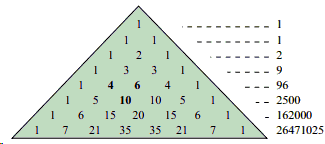e in the Pascal Triangle
Harlan Brothers has recently discovered the fundamental constant e hidden in the Pascal Triangle; this by taking products - instead of sums - of all elements in a row:

If \(s_n\) is the product of the terms in the \(n\)th row, then
\(\displaystyle \mbox{lim}_{n\rightarrow\infty} \frac{s_{n-1}s_{n+1}}{s_{n}^{2}} = e. \)
Proof
The terms in the \(n\)th row of the Pascal Triangle are the binomial coefficients \({n\choose k}\) so that
\(\displaystyle s_{n}=\prod_{k=0}^{n}{n\choose k}=\frac{(n!)^{n+1}}{\prod_{k=0}^{n}k!^{2}}. \)
This gives
\(\displaystyle \begin{align} \frac{s_{n+1}}{s_{n}} &= \frac{(n+1)!\space ^{n+2}}{(n!)^{n+1}}\cdot\frac{\prod_{k=0}^{n}k!^{2}}{\prod_{k=0}^{n+1}k!^{2}}\\\\ &= \frac{(n+1)^{n+2}n!}{1}\cdot\frac{1}{(n+1)!^{2}}\\\\ &= \frac{(n+1)^{n+1}}{(n+1)!}\\\\ &= \frac{(n+1)^{n}}{n!}. \end{align} \)
It follows that
\(\displaystyle \begin{align} \frac{s_{n+1}s_{n-1}}{s_{n}^2} &= \frac{(n+1)^n}{n!}\cdot\frac{(n-1)!}{n^{n-1}}\\\\ &= \bigg(\frac{n+1}{n}\bigg)^n\\\\ &= \bigg(1+\frac{1}{n}\bigg)^{n}. \end{align} \)
Which is a well known expression whose limit is \(e\).
References
- H. J. Brothers, Pascal's triangle: The hidden stor-\(e\), The Mathematical Gazette, March 2012, 145
- H. J. Brothers, Finding e in Pascal's triangle, Mathematics Magazine, 85, No. 1 (2012), 51
Pascal's Triangle and the Binomial Coefficients
- Binomial Theorem
- Arithmetic in Disguise
- Construction of Pascal's Triangle
- Dot Patterns, Pascal Triangle and Lucas Theorem
- Integer Iterations on a Circle
- Leibniz and Pascal Triangles
- Lucas' Theorem
- Lucas' Theorem II
- Patterns in Pascal's Triangle
- Random Walks
- Sierpinski Gasket and Tower of Hanoi
- Treatise on Arithmetical Triangle
- Ways To Count
- Another Binomial Identity with Proofs
- Vandermonde's Convolution Formula
- Counting Fat Sets
- e in the Pascal Triangle
- Catalan Numbers in Pascal's Triangle
- Sums of Binomial Reciprocals in Pascal's Triangle
- Squares in Pascal's Triangle
- Cubes in Pascal's Triangle
- Pi in Pascal's Triangle
- Pi in Pascal's Triangle via Triangular Numbers
- Ascending Bases and Exponents in Pascal's Triangle
- Determinants in Pascal's Triangle
- Tony Foster's Integer Powers in Pascal's Triangle
|Contact| |Front page| |Contents| |Algebra|
Copyright © 1996-2018 Alexander Bogomolny71551956
